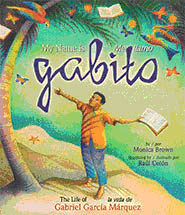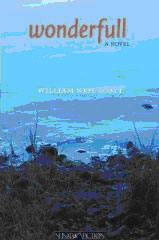

Book Reviews
by Tamara Kaye Sellman
My Name is Gabito/Wonderfull
Reviews by Tamara Kaye Sellman, MRCentral.net

My Name is Gabito (Me llamo Gabito)
by Monica Brown, illustrations by Raúl Colón
por Monica Brown, illustrado por Raúl Colón
One of my favorite trends in children's books centers on beautiful picture book biographies of famous artists. I adore Jonah Winter's Frida, which is sweetly illustrated by Ana Juan. One wintertime title my family should just buy outright (since we used to check it out from the library all the time) is Snowflake Bentley by Jacqueline Briggs Martin; it features farmer Wilson A. Bentley, who first discovered how to photograph snowflakes. And Charlie Parker Played Bebop (by Chris Raschka) is still a family favorite around in our house. With that in mind, it was a thrill for me to learn that a picture book illustrating the life of Gabriel García Márquez had been released in 2007.
My Name is Gabito || Me llamo Gabito is a gorgeously illustrated bilingual format picture book. Author Monica Brown has also written similar books featuring the first Latina Nobel prizewinner, Gabriela Mistral, and Cuban singer, Celia Cruz.
It's my understanding that Brown did not directly interview Gabriel García Márquez for her information but, rather, read his memoir, Living to Tell The Tale, and was already deeply familiar with his epic novels and short stories, in order to re-imagine and convey his childhood and subsequent writing career in picture-book format. That being said, Brown does a nice job of capturing a theoretical genesis of Gabo's early life as writer.
The text mentions his home town of Aracataca in Colombia and the sumptuous and magical landscape in which he was raised, which opens a potential gate to a young reader's later understanding and appreciation of the roots of Macondo. Gabito's grandfather is especially honored in this book for his storytelling finesse, and the presence of the man's giant dictionary is credited, from which "Gabito learned that magic is not just for witches, that gypsies are wanderers with a taste for adventure, and that words can be big and great and wild, too."
In addition, simple, thoughtful references to observations Gabito made about the local banana workers give relevant insight into García Márquez's later political activism and reasons for his voluntary exile, though these later developments are (appropriately) not discussed in this book. After all, for readers between the ages of 4 and 8, it's much more inspiring and delightful to illustrate the jewel-like magic of the hero's journey.
So who will be next? Franz Kafka? Salman Rushdie? Ben Okri? Janet Frame? Angela Carter? I feel like a kid in a candy shop! If any of these potential titles are produced as thoughtfully and aesthetically as My Name is Gabito || Me llamo Gabito, then I'd like to reserve one copy of each, please.

Wonderfull, by William Neil Scott
Not only is the double L in the title of this book fully intended, but it is equally well deserved. Wonderfull is nothing if not brimming with marvels typically reserved for stories written in the vein of García Márquez.
But William Neil Scott is not Colombian, he's Canadian. And the solitary town where marvels dwell is not Macondo, but Garfax, a quaint shoreside hamlet founded by a pair of shipwrecked Scottish men in 1896 who failed to determine proper claims over their newfound domain due to a stalmate in dominoes which persists even in death.
So begins this charming family romance with magical realist elements. Consider the following:
- the story is narrated by an 11-year-old child reciting, quite reliably, the events transpiring in modern-day Garfax
- the narrator's parents are special: his mother, Emma Brodie, is a clairvoyant who remembers the future, and his father, Cadmus, moves between the realms of the living and the dead like a man walking from one room to the next
- the dead relatives of the family, aka the aforementioned founders of Garfax, still play their endless game of dominoes in the house where the Brodie family resides in the present day, and
- the town itself has been forsaken by cartography, having no representation on any map of Canada's Atlantic shore
If you suspect there might be similarities between García Márquez's One Hundred Years of Solitude and Scott's Wonderfull, you'd be right. The story is essentially the same: a legendary lost town of humble origins is forced to come to terms with its future.
Both share quirky landscapes and characters as well. In Scott's version, it's a town which once relocated to the deep of the woods to avoid the meddling of government census officials (which is not entirely unbelievable—at around that time in Canada, rural communities during the Northwest Resistance fended off bureaucrats because they felt they were being exploited to serve Eastern business interests). In Garfax, there is a one-armed cab driver named Lizzie, a home split into five pieces, a conversation-broadcasting radio, and a ring of pine trees that plays host to chatty dead folks in need of salvation from a wandering priest. There's even a girl who must carry rocks in her pocket so that she won't float away (Remedios, anybody?). If you have read One Hundred Years of Solitude prior to reading Wonderfull, you won't be able to ignore the echoes.
But you won't be disappointed either. I absolutely loved Scott's light, lyrical prose and renderings of small town eccentricities (which reminded me of Northern Exposure in so many delightful ways). Despite these outside comparisons, I think these stories of Garfax are funny, quaint, and poignant, with a fresh, inventive quality to them. I live in a small rural island town myself and can relate to the hodgepodge of personalities that Scott blends together to populate the fishbowl that is Garfax.
I also enjoyed the narrator's storytelling style, moving in and out of anecdotes so smoothly I often forgot where the story began and yet didn't feel lost at all. Or if I was lost, I was happy to be so. I learned by the end of the first chapter that I could trust the author to bring me back to where I needed to be. He does all this well, albeit in a structure that resembles layers of concentric circles and figure 8s.
Wonderfull is a novel in stories with no familiar linear anchor to cling to, and the reader is left to disentangle the truth from the dozens of shining threads spun out from the telling. For some, that could be problematic, but my feeling is that fans of magical realism will easily adapt to the multidirectional qualities of this small town tall tale and, indeed, revel in the charming oddity of life in Garfax: past, present and future.
Note: Bookmark, an audio production program dedicated to Alberta, Canada's literary scene and hosted by book publishing executive Ken Davis, will broadcast an interview with Scott and a feature on Wonderfull on Sunday, June 1. CKUA radio programs can be heard on below radio frequencies throughout Alberta, through the StarChoice satellite system on channel 828 throughout Canada, or worldwide through their Windows Media stream. For more information
Story Copyright © 2008 by Tamara Kaye Sellman. All rights reserved.
Previous: The Kingdom of this World by Katy Wimhurst | Next: Margaret Cavendish by Elaine Walker
About the author
 Tamara Kaye Sellman is the publisher of Margin: Exploring Modern Magical Realism (www.magical-realism.com) and director of MRCentral.net, an interactive membership celebrating literary magical realism worldwide.
Tamara Kaye Sellman is the publisher of Margin: Exploring Modern Magical Realism (www.magical-realism.com) and director of MRCentral.net, an interactive membership celebrating literary magical realism worldwide.
Home
|
Competition
|
Privacy
|
Contact
|
Sponsorship